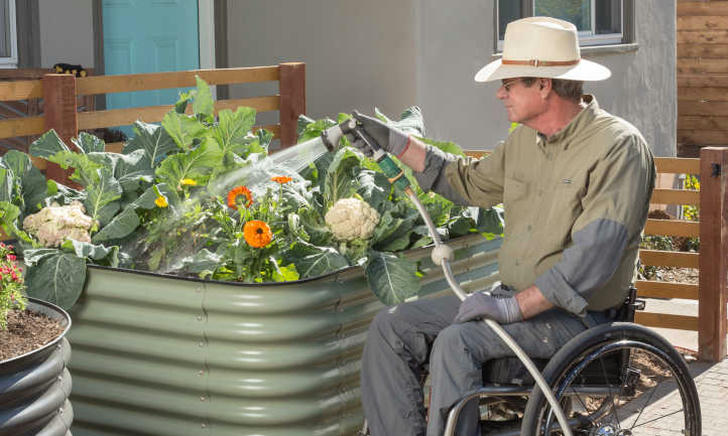Wheelchair-Friendly Gardening: Elevated Raised Bed Planting Solutions
Gardening is a cherished activity for many, offering not just the joy of nurturing plants but also the therapeutic benefits of being outdoors. However, for seniors and individuals with mobility challenges, traditional gardening can be difficult. Fortunately, wheelchair-friendly elevated raised beds provide an accessible solution that allows everyone to enjoy the beauty and satisfaction of gardening without the physical strain often associated with bending or kneeling. This article will explore how to create a wheelchair-accessible garden using elevated raised beds, making gardening enjoyable and rewarding for all.

Understanding Elevated Raised Beds
Elevated raised beds are garden structures that are designed to be higher off the ground, allowing individuals in wheelchairs or those who have difficulty bending to easily reach their plants. These beds typically stand at a height of 28 to 34 inches, making them accessible from a seated position. The design not only accommodates wheelchair users but also provides ergonomic benefits for all gardeners by reducing strain on the back and knees.
Key Features of Accessible Raised Beds
Height: The ideal height for an elevated raised bed is between 28 and 34 inches. This ensures that users can comfortably reach into the bed without straining.
Width: The width of the bed should not exceed 2 feet to allow easy access from either side. This is particularly important for wheelchair users who need to reach plants without stretching too far.
Material: Elevated raised beds can be constructed from various materials, including wood, metal, or composite materials. It's essential to choose durable materials that can withstand outdoor conditions while being safe for planting.
Design: Consider designs that allow for easy access from multiple angles. U-shaped or L-shaped configurations can provide greater accessibility and make it easier to tend to plants.
Pathways: Ensure that there are clear pathways leading to the raised beds. These pathways should be wide enough to accommodate a wheelchair and free from obstacles.
Benefits of Elevated Raised Beds
Accessibility: Elevated raised beds make gardening accessible for individuals with limited mobility, allowing them to participate in this rewarding activity without physical discomfort.
Comfort: Gardening at an elevated height reduces the need for bending or kneeling, making it easier on the joints and back.
Soil Quality: Raised beds often have better drainage and soil quality compared to traditional garden plots, leading to healthier plants.
Pest Control: Elevating the garden bed can help deter pests like rabbits and groundhogs, providing a safer environment for your plants.
Aesthetic Appeal: Elevated raised beds can enhance the beauty of your garden space, adding structure and design elements that are visually appealing.
Steps to Create Your Wheelchair-Friendly Garden
1. Choose the Right Location
Select a location that receives adequate sunlight (at least six hours a day) and has good drainage. Avoid areas with standing water or heavy shade from trees or buildings.
2. Plan Your Design
Decide on the size and shape of your elevated raised beds. Consider how many beds you want and how they will be arranged in relation to pathways for easy access.
3. Gather Materials
Purchase materials based on your design plan:
Wood: Cedar or redwood is recommended due to its natural resistance to rot.
Metal: Galvanized steel or aluminum can provide durability.
Composite Materials: These are often low-maintenance and resistant to weathering.
Soil: Use high-quality potting soil mixed with compost for optimal plant growth.
4. Build Your Raised Bed
Construct your elevated raised bed according to your design specifications:
Frame Construction: Create a sturdy frame using your chosen material.
Height Adjustment: Ensure that the height meets accessibility standards.
Drainage Holes: If using wood or metal, drill holes in the bottom for drainage.
Liner (optional): Consider adding a liner to prevent soil erosion and retain moisture.
5. Fill with Soil
Fill your raised bed with a mixture of potting soil and compost, ensuring it is nutrient-rich and well-draining.
6. Plant Your Garden
Choose plants that are suitable for your climate and growing conditions:
Vegetables: Consider easy-to-grow options like tomatoes, peppers, lettuce, and herbs.
Flowers: Select colorful annuals or perennials that thrive in your area.
Accessibility Considerations: Opt for plants that do not require extensive bending or reaching.
7. Maintenance
Regularly check your garden for weeds, pests, and watering needs:
Watering System: Consider installing a drip irrigation system for efficient watering without heavy lifting.
Mulching: Use mulch to retain moisture and suppress weeds.
Recommended Products for Your Wheelchair-Friendly Garden
To help you get started with your elevated raised bed gardening project, here are some affordable products available on Amazon:
Raised Garden Bed Kit
- Look for kits made from durable materials that come with all necessary components for easy assembly.
Ergonomic Garden Tools
- Invest in tools designed specifically for ease of use, such as long-handled trowels and weeders that reduce strain on the back.
Drip Irrigation Kit
- A drip irrigation system can simplify watering tasks while ensuring your plants receive consistent moisture.
Garden Kneeler and Seat
- While primarily designed for kneeling gardeners, these versatile seats can also provide support when reaching into elevated beds.
Raised Bed Soil Mix
- Purchase pre-mixed soil specifically designed for raised beds; this ensures optimal drainage and nutrient content.
Plant Labels
- Keep track of your plant varieties with waterproof plant labels; this is especially helpful if you’re growing multiple types of vegetables or flowers.
Gardening Gloves
- Protect your hands while working in the garden with comfortable gloves designed for gardening tasks.
Conclusion
Creating a wheelchair-friendly elevated raised bed garden is an excellent way to enjoy gardening without physical limitations. By following these steps and incorporating thoughtful design elements, you can create an accessible space that allows everyone to experience the joys of nurturing plants while promoting well-being through nature engagement. With the right resources and commitment, you’ll find that gardening can be both fulfilling and enjoyable at any age or ability level!
